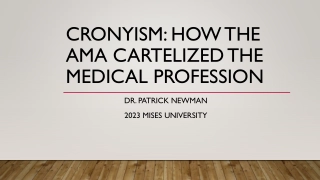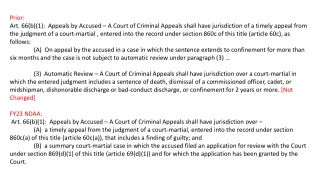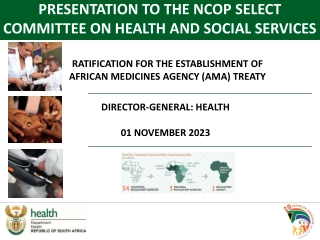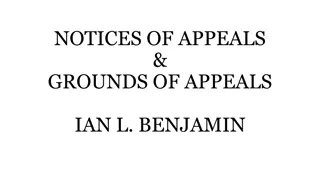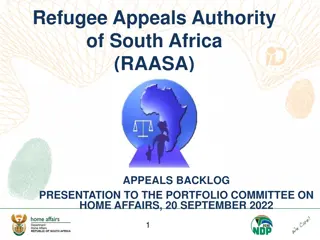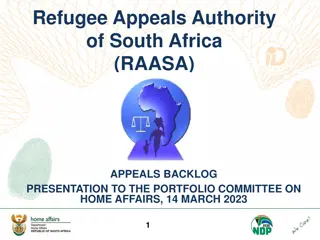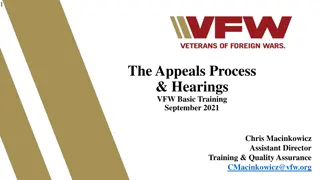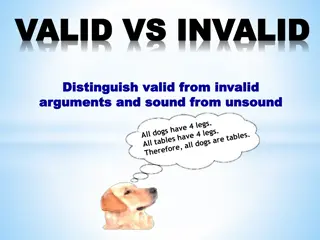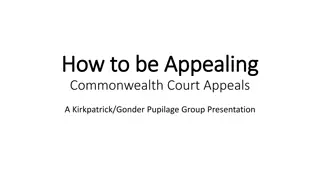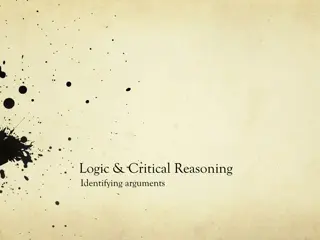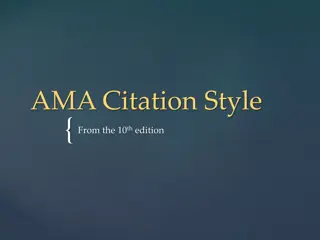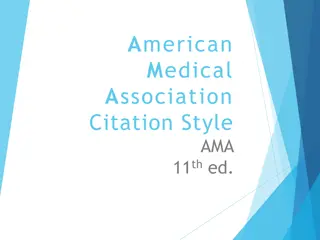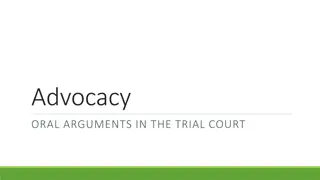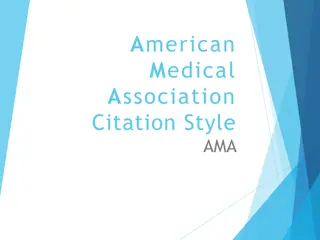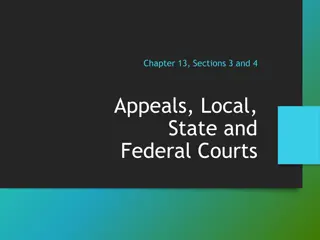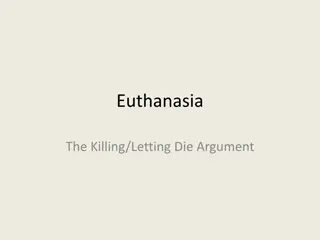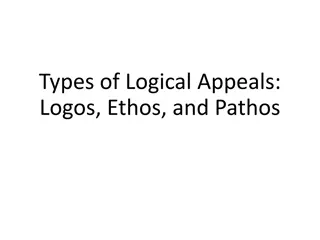
Effective Strategies for Writing AMA Appeals Arguments
Enhance your knowledge on writing AMA appeals arguments with comprehensive instructions on identifying issues on appeal, using benefit of the doubt, presenting references, and requesting a remand at the BVA. This session aims to equip VFW accredited representatives with the skills needed to support an AMA appeal effectively.
Download Presentation

Please find below an Image/Link to download the presentation.
The content on the website is provided AS IS for your information and personal use only. It may not be sold, licensed, or shared on other websites without obtaining consent from the author. If you encounter any issues during the download, it is possible that the publisher has removed the file from their server.
You are allowed to download the files provided on this website for personal or commercial use, subject to the condition that they are used lawfully. All files are the property of their respective owners.
The content on the website is provided AS IS for your information and personal use only. It may not be sold, licensed, or shared on other websites without obtaining consent from the author.
E N D
Presentation Transcript
Writing AMA Appeals Arguments Jeffrey P. Wishneski Manager, BVA September 16, 2020
Functions Check Before we get started, let s perform a functions check to ensure everyone can participate and follow along. Ensure that you re in a quiet space in your home or office Ensure that your computer is charged and/or plugged in. Next, please keep your microphone on mute unless you are speaking. To mute or unmute your microphone, click on the microphone icon in the lower, left corner of the screen. Click on the icon to mute or unmute You can start or stop your video at any time by clicking on the video icon in the lower, left corner of the screen. Click on the icon to start or stop. 3
Functions Check If you re having trouble hearing the presentation, first ensure that your volume is on and turned up. Then, if using headphones, check the settings by using the arrow next to the microphone icon to ensure that you re using the correct settings for headphones. To use the chat feature, click on the chat icon at the bottom, middle of the screen. You can choose to chat with everyone or a specific person by using the arrow. 4
Functions Check To access user interactions, click on the Participants icon The interactions tool bar will appear at the bottom, right side of the screen. You can virtually raise your hand, answer yes or no questions from the instructor, or notify the instructor that they are moving too fast or too slow. Additional options are accessed by clicking on the more button. You can virtually clap, like or dislike, as well as other options. 5
Functions Check If you have a QUESTION during the presentation, please enter a question mark (?) or enter your question into the chat box and the presenter or facilitator will address your question. PLEASE WAIT UNTIL YOU ARE RECOGNIZED BEFORE UNMUTING YOUR MICROPHONE If you re having technical difficulties please contact the Technical Advisors listed in the agenda. If you need a comfort break, please do so and return as soon as possible. Please remember, these sessions will be recorded for future use. Everything on the internet lasts forever! 6
Lesson Objectives: Distinguishing Legacy v. AMA How to properly identify issues on appeal How to properly use benefit of the doubt How to present references How and when to request a remand at the BVA due to a duty to assist error (38 CFR 3.159 (c) /M21-1, Part I, Chapter 1, Section A) With the purpose of providing VFW accredited representatives comprehensive instruction on how to properly present written argument to the VA in support of an AMA appeal 7
Lesson Objectives continued: Why are we teaching this class again? We are seeing claims filed with little or no argument on a regular basis this lacking creates inadequate representation that could have been avoided We need YOU to be the primary contact with the veteran/family member who can direct the individual to obtain the necessary evidence within a reasonable period of time. If we wait until the appeal reaches the Board, clients become frustrated because they weren t told about the required information sooner and we may not have sufficient time to request the information. This places the claim at a distinct disadvantage and further frustrates the veteran. You can filter out meritless claims before they become a problem for the VFW 8
Background: In August of 2017, Congress revised the appeals process allowing for two different types of appellate procedures: Legacy and AMA Appeals. The new AMA process went into effect on February 19, 2019. Both processes require timely filing. In the era of Covid-19, argument can be made that disruptions and unexpected delays have caused untimely filing. BVA rules and regulations can be found in Title 38 of the Code of Federal Regulations (CFR), part 19-20. Absent compelling circumstances, the VFW does not accept representation in an appealed case once the appeal has been filed or while in remand status. 9
Volume at the Board: 1/1/2020 8/31/2020 1869 Legacy appeals received 807 originals 1062 post-remands 33.1% allowed 41.0% remanded 21.0% denied 4.9% other (5,501 Legacy decisions) Statistics on AMA cases is a work-in-progress however presently we have 1441 cases 10
Legacy v. AMA: AMA Receive Decision Provide new & relevant evidence to file Supplemental Claim or File HLR (No new evidence) or 10182 Appeal to BVA 11a Direct Review (No new evidence) 11b Evidence Submission (90 days) 11c Hearings (with or without new evidence) Legacy Receive Decision File NOD selecting Traditional or DRO Review (1yr) Statement of the Case issued File VA Form 9 (60 days) NOTE: New Legacy claims are no longer accepted. Therefore, do not file a NOD, VAF-9, or VAF-646. 11
When Working on an Appeal: Analyze the facts List applicable rules & regulations Conclude with the desired outcome Write clearly and persuasively It is a process that takes time 12
IRAC Appeal Writing Method: Issue Rule Analysis Conclusion This is the most common writing method used to present an argument Most development should be done before the claim reaches the BVA allowing for the best argument(s) to be presented 13
Identifying the Issue: The issue is already presented to you in the decision and is phrased in terms of: entitlement to the issue of service-connected compensation for Hearing Loss increased rating for Hearing Loss earlier effective date for Hearing Loss Some common appeals we are seeing contain inadequate exams, lack an opinion/rationale, and reference non-related exams. This causes delays and can prevent favorable decisions. 14
Misstated Issues: Some common misstated issues we see in appeals originating by our service officers are: earlier effective date v. increased rating or earlier effective date v. service connection separate ratings v. increased ratings disagreement with the creation of an overpayment v. a request for a waiver of an overpayment the fact that you never owed benefits v. telling VA you should not have to pay 15
Recognizing applicable rule: After identifying the issue start with the facts and match them with the rules that apply or vice versa Review the rating decision to see which criteria VA indicated the veteran did not meet (based on presented evidence) Summarize the facts What supports the veteran s position Use bullet points 16
Non-meritorious Appeals: No way to argue or change the facts favorable to veteran or family member - so what do you do? Ask: what new and relevant evidence* might help? *[38 CFR 3.2501(a)(1)] Other suggestions? 17
Analysis / Argument: Benefit of the doubt doctrine (38 C.F.R. 3.102) Only use when evidence is in approximate balance or equipoise(ex. 2 medical opinions, 1 positive & 1 negative) Ex: The veteran s general practitioner said the veteran has (PTSD) but the VA psychiatrist said he/she does not. Does the doctrine apply? Why/why not? If the evidence is 51% or more in favor of the veteran, there is no need to argue benefit of the doubt Ex: The veteran s private psychiatrist says (PTSD) while his/her VA or private GP questions him/her having (PTSD), or, says they do not have (PTSD). Do you use benefit of the doubt or not? Why? 18
Analysis / Argument: Failure of duty to assist (38 C.F.R. 3.159) These are not the only DTA errors, but they are the most common we see at the Board Records identified but not obtained Medical exam is warranted because evidence meets the threshold for providing an examination under (38 C.F.R. 3.159(c)) but isn t scheduled What other ones? How would you argue this type of issue? 19
Analysis / Argument: Inadequate medical examination (38 C.F.R. 3.326) Did not consider veterans lay statements Did not complete all required tests/exams Performed by unqualified individual No or weak rationale provided for opinion Did not review VBMS file (veteran s medical and military history) 20
Analysis / Argument continued: Inadequate medical examination example Joe Veteran attended a scheduled VA examination on June 20, 2015 at VAMC SD where he was seen for approximately ten minutes by Medical Intern Bob Beginner for a chronic neck and back condition Joe brought a list of symptoms and severity notes to provide the doctor which were not accepted because Bob was running behind on appointments and had to rush to the next one after asking just two questions about Joe s walk and stating he was the doctor, not Joe Two weeks later Bob submitted a partial opinion in which he acknowledged he did not review Joe s VBMS file which contained prior treatment records for the same conditions as well as his military personnel records which included his DD-214 that acknowledged he was authorized the air assault badge while serving with the 101st Airborne 21
Analysis / Argument continued: Bob s opinion contained limited rationale that focused on Joe s limp Joe requested and received a copy of the medical notes and immediately filed a Statement in Support of Claim with Central Intake alleging an inadequate examination and his willingness to attend another examination with a different examiner prior to any decision by the Board What else can you add to the argument to assist Joe? Mention he hasn t had an examination in years and he s disappointed Mention he s waited a long time for the exam to be scheduled due to Covid-19 Mention that the notes he wanted to provide remain available and include them 22
References/Citations: Cite 38 C.F.R. www.ecfr.gov M21-1 (note: the M21-1 is not law) www.knowva.ebenefits.va.gov VA O.G.C. Precedent Opinions https://www.va.gov/ogc/precedentopinions.asp U.S. Court of Appeals for Veterans Claims www.uscourts.vavc.gov U.S. Court of Appeals for the Federal Circuit www.cafc.uscourts.gov Vet.App - West s Veterans Appeals Reporter A single judge decision = no precedent Need a panel of judges to set precedent 23
References/Citations continued: Referencing similar cases that are not precedent setting: It is acceptable to reference similar cases in an attempt to influence a decision. Although not binding, the facts of a similar case could help strengthen your argument This does not mean that VA is mandated to follow the example of the referenced case When referencing a similar case, ask yourself why VA made the decision and is it (the why) relevant to your assigned case 24
Conclusion: Ask for outcome based on analysis of rules and evidence: Grant benefit sought Restore benefit reduced or eliminated Request additional development i.e., exam or obtain records Do not ask for an outcome that is not possible 25
Clear Writing: Elements of clear writing include: Logical organization Short sentences Short paragraphs Common words & phrases Active v passive voice Use of headings/titles to distinguish & focus attention Proof-read & use Spellcheck Proof-read & use Spellcheck Proof-read & use Spellcheck! 26
Persuasive Writing: We represent the veteran/family member and the VFW organization Write to influence Be informative Build your case Explain the problem Provide evidence Give a solution (that is legally possible) Be effective Stay positive, pleasant and professional 27
Common pitfalls to avoid when writing: Do not bring up new issues in an appeal, address them properly using the correct VA form Do not use canned arguments (tailor it) Do not cite regulations or laws that do not apply (credibility) Stick to what s relevant and avoid what is not Write to support the claim 28
Common pitfalls continued: Far too common mistakes: Spelling errors easily corrected by proofreading & spell checking Is there merit to the claim? don t build false hopes Do not use the wrong citation number Only use Benefit of the Doubt when it applies 29
Scenario 1 : Joe Veteran seeks service connection for (PTSD) but was never deployed and never saw combat. He served 18 months 12 years ago and believes he is entitled to a 100% rating with a huge retro payment. He has no present diagnosis and no nexus statement which is why VA denied his claim. In fact, he hasn t seen a doctor in years. How would you build his argument? What would you ask him when researching his appeal? What would you explain to him? 30
Scenario 2 : Sally Veteran seeks an increased rating for bilateral hearing loss presently rated 20%. She filed a claim and received a denial from the VA stating there was no evidence to warrant an increased rating. She served 8 years as a helicopter pilot in Iraq and is also service-connected for Tinnitus at 10%. She had her one and only audiology examination shortly after leaving the service fourteen years ago. She is presently employed by D.C. public schools as a high school English teacher but moonlights on weekends as a helicopter instructor. What would you ask the veteran before writing her appeal? How would you build her argument? 31
Scenario 3: Bob Veteran is seeking an earlier effective date for his service-connected ankle, knee and back conditions. He is presently rated 10%, 20% and 40% respectively for each condition with an effective date that coincides with his most recent post-service examination in 2012. The veteran filed his claim via a BDD site (Ft. Belvoir) in 2011 after serving two years from 2009- 2011. He is authorized the parachutist and air assault badges. His MOS was Infantry. He never deployed and frequented the medic while briefly stationed at Ft. Riley for migraines. He believes his effective date should go back to 2009 when he joined the service because he never experienced these conditions prior to enlistment. How would you build his argument? What would you ask from the VA? 32
Scenario 4: Gary Veteran served 32 years and retired as a highly decorated E-9 having served in Vietnam and the Persian Gulf War. His MOS included combat infantry and he is authorized the (CIB). He is married with three children all in college. Gary suffered a medical emergency two years ago while vacationing which required admittance to a private hospital near his vacation rental. He incurred a debt of $3,000 and believes he should be entitled to a waiver of the expense since served his country proudly and did not intend to become sick. There were no VA hospitals in the community, and he claims he would have gone to one if available. Gary filed his claim at the VARO which resulted in a denial. He believes his VA file supports his argument that he shouldn t have to pay the private facility because he served. His initial claim also included a claim for Tinnitus which was denied due to lack of a nexus statement. How would you build his argument? What would you ask from the veteran and/or VA? 33
Scenario 5: Christine enrolled in college at the University of Colorado where she participated in the Air Force R.O.T.C. program. Unfortunately, in her second semester she didn t study and dropped out of school. She subsequently found a job with Verizon installing cable systems. She developed a back condition and obtained a diagnosis. She filed a VA claim for service connection alleging she is a veteran having participated in R.O.T.C. during the Gulf War. The R.O. denied her claim and she appealed to the BVA. She is a member of the VFW Auxiliary through her father who served during Vietnam and is rated 70% combined. Her father is a Life Member of the VFW and The Grand Mystic Royal Order of the Nobles of the Ali Babba Temple of the Shrine. How would you build her argument? What would you ask from the veteran and/or VA? What would you explain to her? 34
Final Scenario For your final scenario you will review a veteran s rating decision along with supporting evidence, then create an appeal argument that adequately represents the veteran s contentions based on the facts of the case. Your grade for this assignment will be based on the overall quality and accuracy of your argument, grammar, and spelling. A total of 20 points are possible. Once you complete the end of conference test, your score for this scenario will be added to your test score in order to create your final score. 35
Final Scenario All of the information you will need to complete this scenario is located in the resources section of the VFW Online Learning Portal and is labeled as September 2020 vASLT Final Appeals Scenario . To access the scenario: Log into the VFW OLP (https://vfw.Psycharmor.org) Select Resources Select September 2020 vASLT Final Appeals Scenario View the file or download using the download button at the bottom of the screen 36
QUESTIONS? Jeff Wishneski (202) 632-4605 Jeffrey.Wishneski@va.gov

